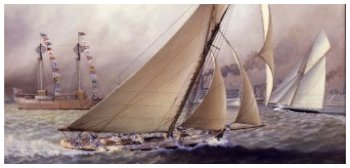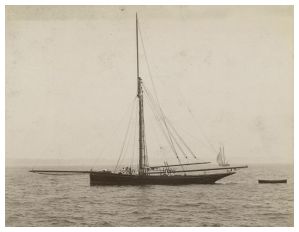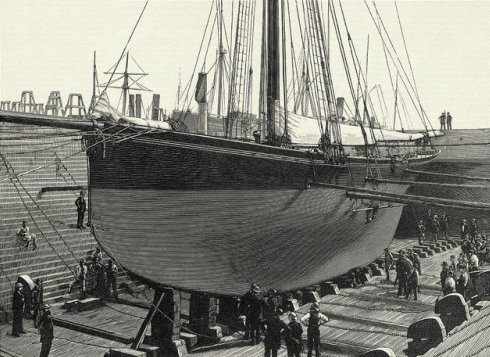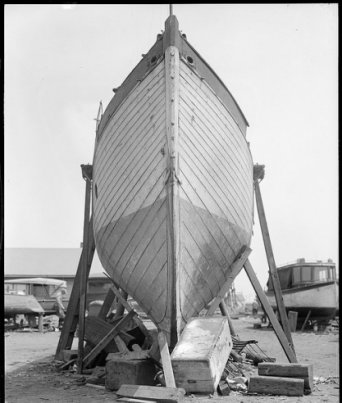Yves GARY Hits: 11142
Category: GENESTA
 English challenger defeated by the American defender Puritan.
English challenger defeated by the American defender Puritan.1884
Genesta was launched in Glasgow and registered in the RYS lists the same year, under Sir Richard Sutton's banner. It was a John Beavor-Webb's design, composite building, John's specialty since Freda (1880).
Her frame was of steel, and she was planked with oak, being the first yacht of composite build to sail for the cup. She was built by D. & H. Henderson & Company, Glasgow.
Genesta sailed an interesting 1884 British yachting season. Out of thirty-four races sailed she won only seven, in one of which she had no competitor, and was beaten seven times by the cutter Marjorie, six times by the cutter Irex, six times by the yawl Larna, four times by the cutter Tara, three times by the yawl Wendur, and once by the cutter Marguerite. She took second place eight times, third place twice, and was distanced seventeen times. Two of her races were won in light or variable breezes, and the rest in steady, fresh, or strong breezes. There is no record of her being beaten in a strong breeze, but in such a breeze on one occasion it took her 5:21:14 to sail 45 miles. Her quickest race was sailed on July 16, 1864, over a 50-knot course of Bangor in 4:04:18. The Wendur and Irex, however, both went over the course in less time.
| Date | Course | Wind | Winner | Genesta | Time |
| May 31, 1834 | Course 50 miles. Southend to Harwich | east by north, light | Genesta | 1st | 8:08:30 |
| June 2 | 40 miles off Harwich | south-east to east, good | Tara | 3rd | 4:15:02 |
| June 3 | 50 miles. Harwich to Southend | east, fresh | Genesta | 1st | 4:49:38 |
| June 4 | 55 miles, Thames to Mouse | north-east, light | Marjorie | 2nd | 9:26:12 |
| June 5 | 50 miles L. Hone Reach Light to Gravesand | north variable | Marjorie | 2nd | 8:16:32 |
| June 7 | 54 miles, Horse to Dover | east, fresh | Genesta | 1st | 7:54:10 |
| June 9 | 50 miles, Dover out and back | northeast to east, light | Larna | 2nd | 5:31:11 |
| June 10 | 50 miles, Dover to Boulogne and back | northeast to east, light | Larna | 2nd | 5:52:44 |
| July 4 | 50 miles. Hunter’s Quay | light and variable | Wendur | not placed | 10:01:49 |
| July 5 | 50 miles. Hunter’s Quay | wind light and variable | Marjorie | not placed | 7:58:27 |
| July 6 | 50 miles. Hunter’s Quay | wind light and variable | ??? | not placed | 6:47:07 |
| July 7 | Milford, around Alisa Craig | variable | Genesta | 1st | 14:46:52 |
| July 8 | 50 miles | south-southwest | Wendur | not placed | 7:59:42 |
| July 11 | 50 miles. Rothsay | moderate | Wendur | 2nd | 6:48:45 |
| July 12 | 50 miles. Rothsay | south moderate | Irex | 2nd | 5:47 :09 |
| July 16 | 50 miles off Bangor | southwest, strong | Genesta | 1st | 4:04:13 |
| July 17 | 33 miles off Bangor | unsteady | Irex | not placed | 5:34:55 |
| July 21 | 50 miles. Dublin Bay | variable | Irex | not placed | 8:19:15 |
| July 23 | 45 miles. Dublin Bay | moderate | Irex | not placed | 7:28:53 |
| July 31 | 38 miles off Plymonth | southwest good | Lorna | 2nd | 5:43:31 |
| Aug. 1 | 38 miles off Plymonth | east, steady | Irex | 3rd | 4:16:31 |
| Aug. 4 | 44 miles off Southampton | west-northwest light | Marguerite | 2nd | 6:13:10 |
| Aug. 5 | 50 miles. Cowes Nab and Yarmonth | east-southeast, light | Marjorie | not placed | 7:59:48 |
| Aug. 6 | 50 miles Cowes around Nab | southeast, light | Larna | not placed | 10:35:30 |
| Aug. 7 | 50 miles Cowes, around Warner and Marks | light and variable | Marjorie | not placed | 13:48:32 |
| Aug. 9 | 46 miles off Southampton | northeast | Tara | not placed | Time |
| Aug. 10 | 45 miles off Cowes | moderate | Marjorie | not placed | 7:06:58 |
| Aug. 12 | 45 miles off Southsea | south-west, strong | Genesta | 1st | 5:21:14 |
| Aug. 14 | 50 miles off Hyde | steady | Genesta sailed over the course without competition | ||
| Aug. 16 | 40 miles off Portsmouth | not indicated | Tara | not placed | not given |
| Aug. 18 | 60 miles off Portsmouth | southwest, good | Irex | not placed | 5:36:01 |
| Aug. 23 | 40 miles off Weymouth | north-west. moderate | Larna | not placed | 7:32:12 |
| Aug. 26 | 50 miles off Torbay | south to northwest fresh at intervals | Tara | not placed | 6:06:02 |
| Aug. 29 | 40 miles. Stool Bay | northwest light | Larna | not placed | 4:53:10 |
1885  Genesta reached New York and dropped anchor off Tompkinsville, Staten Island,on July 16th, 1885, after making the fastest passage on record for a sailing yacht across the Atlantic. It had taken her just 22 days to make the run from Queenstown. Most of the time the weather was fair, the wind was favorable, and the little vessel bounded as merrily over the waves as though she were racing competitors in the English Channel. She ran 1.100 miles at one stretch in five days.
Genesta reached New York and dropped anchor off Tompkinsville, Staten Island,on July 16th, 1885, after making the fastest passage on record for a sailing yacht across the Atlantic. It had taken her just 22 days to make the run from Queenstown. Most of the time the weather was fair, the wind was favorable, and the little vessel bounded as merrily over the waves as though she were racing competitors in the English Channel. She ran 1.100 miles at one stretch in five days.
To everyone's surprise, the British started the secrecy that has since persisted throughout Cup history. As soon as the challenger reached the dry dock on September 2nd, 1885, for a final polishing of the hull, Beavor-Webb refused to let anyone see his yacht.
The Genesta's crew for the coming races consists of Capt. John Carter, formerly skipper of the English cutter Molna; Pilot Joe Nelson, Mate William Fosgate, and 16 men before the mast.

 America's Cup races
America's Cup racesSailed on September 14 to 16, 1885 in New York
Best two out of three races.
Genesta the challengervs. Puritan the defender
Alternating Inside & Outside Course as in 1871, with the first leg to leeward and return leg to windward. Races: two sailed. Genesta was beaten by Puritan two wins to nil.
- September 14, 1st race, 32.6 miles, Inside Course: Puritan beat Genesta by 16 minutes 19 sec in corrected time.
- September 16, 2nd race, 32 miles, Outside Course: Puritan beat Genesta by 1 minute 38 sec in corrected time.

 After the Cup races, Sir Richard Sutton sailed some regattas organised on the East coast, aboard Genesta. He won the Brenton Reef Cup and the Cape May Challenge Cup, and brought them back to England with him.
After the Cup races, Sir Richard Sutton sailed some regattas organised on the East coast, aboard Genesta. He won the Brenton Reef Cup and the Cape May Challenge Cup, and brought them back to England with him.
1887
Genesta won the first Round Britain Race that was held in 1887 to celebrate Queen Victoria's Jubilee. It covered the 1590-mile course in 12 days, 16 hours, 59 minutes, and appears to have led all the way.
1889
Registered in the Royal Yacht Squadron lists under Sir Richard Sutton, it was sold and converted as a yawl.
1900
Genesta did not sail as a yacht. It was broken up in 1900…
Famous old English cup defender at South Boston Yard |
|||
 |
 |
||
